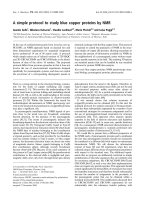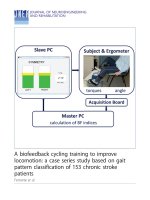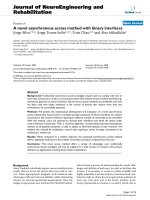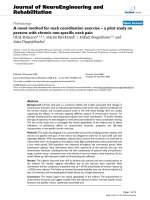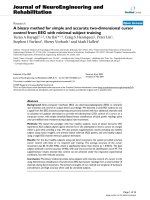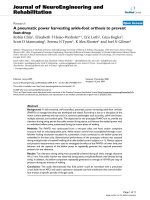Báo cáo hóa học: "A Simple Method to Synthesize Cadmium Hydroxide Nanobelts" pptx
Bạn đang xem bản rút gọn của tài liệu. Xem và tải ngay bản đầy đủ của tài liệu tại đây (371.81 KB, 5 trang )
NANO EXPRESS
A Simple Method to Synthesize Cadmium Hydroxide Nanobelts
D. E. Zhang Æ X. D. Pan Æ H. Zhu Æ S. Z. Li Æ G. Y. Xu Æ
X. B. Zhang Æ A. L. Ying Æ Z. W. Tong
Received: 6 May 2008 / Accepted: 11 July 2008 /Published online: 9 August 2008
Ó to the authors 2008
Abstract Cd(OH)
2
nanobelts have been synthesized in
high yield by a convenient polyol method for the first time.
XRD, XPS, FESEM, and TEM were used to characterize
the product, which revealed that the product consisted of
belt-like crystals about 40 nm in thickness and length up to
several hundreds of micrometers. Studies found that the
viscosity of the solvent has important influence on the
morphology of the final products. The optical absorption
spectrum indicates that the Cd(OH)
2
nanobelts have a
direct band gap of 4.45 eV.
Keywords Crystal morphology Á Nanobelt Á Viscosity Á
Hydrothermal
Introduction
One-dimensional (1D) nanostructures such as wires, rods,
belts, and tubes, whose lateral dimensions fall anywhere in the
range of 1–100 nm, have become the focus of intensive
research, owing to their unique applications in mesoscopic
physics and fabrication of nanoscale devices [1–6]. Among
one-dimensional (1D) nanostructures, nanobelts (or nanorib-
bons), a relatively new family of 1D nanostructures with a
rectangular cross section, have received increasing attention
since the discovery of novel oxide semiconductor nanobelts
[4–8]. A variety of functional oxide [3, 9] and sulfide [10–17]
nanobelts have been successfully fabricated by simple thermal
evaporation. The methods used in 1D nanostructure synthesis
and hydrothermal processes have emerged as powerful tools
for the fabrication of anisotropic nanomaterials with some
significant advantages, such as controllable particle size and
low-temperature, cost-effective, and less-complicated tech-
niques. Under hydrothermal conditions, many starting
materials can undergo quite unexpected reactions, which are
often accompanied by the formation of nanoscopic morphol-
ogies that are not accessible by classical routes [18]. In recent
years, 1D nanomaterials such as Ln(OH)
3
[19–21], CdWO
4
[22], MoO
3
[23], and Dy(OH)
3
[24]havebeensuccessfully
synthesized using hydrothermal methods.
Cadmium hydroxide, Cd(OH)
2
, is a wide band gap semi-
conductor [25] with a wide range of possible applications
including solar cells, photo transistors and diodes, transparent
electrodes, sensors, etc. [26, 27]. Cadmium hydroxide is also
the precursor to prepare cadmium oxide [18]. As a conse-
quence, numerous techniques have been proposed to
synthesize nano-sized Cd(OH)
2
particles with promising
control of properties [25–28]. However, up to now, to our best
knowledge, the synthesis of Cd(OH)
2
nanobelts by hydro-
thermal process has not been reported. Herein, we report the
preparation of cadmium hydroxide nanobelts by the conven-
tional polyol assisted hydrothermal process.
Materials and Methods
In a typical procedure; CdCl
2
Á 2H
2
O (0.2281 g) was dis-
solved in 32 mL of distilled water, and then NH
3
Á H
2
O
(25 wt.%, 5 mL) was slowly added into the solution and
stirred for about 10 min, and a transparent Cd(NH
3
)
4
2-
D. E. Zhang (&) Á X. D. Pan Á H. Zhu Á S. Z. Li Á
G. Y. Xu Á X. B. Zhang Á A. L. Ying Á Z. W. Tong
Department of Chemical Engineering, Huaihai Institute of
Technology, Lianyungang 222005, People’s Republic of China
e-mail:
Z. W. Tong (&)
SORST, Japan Science and Technology Agency (JST), Tokyo,
Japan
e-mail:
123
Nanoscale Res Lett (2008) 3:284–288
DOI 10.1007/s11671-008-9150-4
solution was formed. Then, the above solution was loaded
into a 50-mL Teflon-lined autoclave, which was then filled
with 8 mL of glycol. The autoclave was sealed, warmed up
at a speed of 3 8C/min and maintained at 100 8 C for 6 h,
and was then cooled to room temperature on standing. The
white precipitate was filtered off, washed with absolute
ethanol and distilled water for several times, and then dried
in vacuum at 40 8C for 4 h.
X-ray diffraction (XRD) patterns were carried out on a
Japan Rigaku D/max rA X-ray diffractometer equipped
with graphitemonochromatized high-intensity Cu Ka radi-
ation (k = 1.541784 A
˚
). The accelerating voltage was set
at 50 kV, with 100 mA flux at a scanning rate of 0.06°/s in
the 2h range 10–80°. The X-ray photoelectron spectra
(XPS) were collected on an ESCALab MKII X-ray pho-
toelectron spectrometer using nonmonochromatized Mg
KR X-ray as the excitation source. The field emission
scanning electron microscopy (FE-SEM) images were
taken on a JEOL JSM-6700FSEM. The transmission
electron microscopy (TEM) images were characterized by
Hitachi H-800 transmission electron microscope with a
tungsten filament and an accelerating voltage of 200 kV.
Results and Discussion
The XRD pattern (Fig. 1) from the as-synthesized bulk
samples reveals the crystal structure and phase purity of the
products. All the diffraction peaks can be indexed to the
hexagonal Cd(OH)
2
with cell constants a = 3.4942,
c = 4.7102, which are consistent with the values in the
literature (JCPDS 31-0228). The abnormally intensified
(100) peak in the XRD pattern also indicates that the belt-
like product comprises 1D Cd(OH)
2
crystals preferentially
grown along the [001] direction.
Figure 2 shows the XPS spectra of the as-obtained
Cd(OH)
2
sample. A survey spectrum shown in Fig. 2a,
indicates the presence of Cd and O as well as C from refer-
ence. There are no peaks for other impurities, indicating that
the as-obtained product is relatively pure. High-resolution
spectra are also taken for the Cd 3d region and the O 1s region
to determine the valency state and atomic ratio. The binding
energies of Cd(3d5/2) and O(1s) were found to be 405.30 and
531.25 eV, respectively. All the above observed binding
energy values are in good agreement with the reported data
[29, 30]. Quantification of the XPS peaks gives the molar
ratio of Cd:O as 1:2.02, close to the stoichiometry of
Cd(OH)
2
. This also validated our speculation in XRD study.
A typical low-magnification FESEM image (Fig. 3a)
shows that the as-synthesized products consist of a large
quantity of 1D nanostructures with lengths from several
tens to several hundreds of micrometers; some of them even
have lengths of the order of millimeters. A representative
high magnification SEM image (Fig. 3b) of several curved
Cd(OH)
2
1D nanostructures reveals that their geometrical
shape is belt-like, which is distinct from those of previously
reported nanowires, and their thickness is about 30–50 nm.
TEM and SAED studies of the as-synthesized products
provide further insight into the belt-like Cd(OH)
2
nano-
structures. Straight and curved Cd(OH)
2
nanobelts can be
observed in Fig. 4b. The nanobelts are uniform in width
and thickness, and their typical widths and thickness are in
the range of 60–250 nm and 10–30 nm, respectively. The
SAED pattern (inset in Fig. 4b) taken from the straight
section of the curved nanobelt demonstrates that this par-
ticular nanobelt is a single crystal.
For the polyol process, glycol was selected as the sol-
vent because of its excellent viscosity, which makes it
possible to mix the reagents homogeneously. In the pro-
cess, glycol can provide reaction conditions adequate to
greatly enhance solubility, diffusion, and crystallization,
but is still mild to leave molecular building blocks to bring
about the formation of the solid-state phase. At reaction
temperature, the diffusion of ions in glycol is more rapid
than in other polyol, such as glycerine and diethylene
glycol; this leads to acceleration in the solubility of starting
materials and in the following crystal growth. Both higher
viscosity and lower viscosity are not beneficial for getting
unique geometrical nanostructures. The concentrations of
glycol of about 20–30 vol.%, were found to be favorable
for the formation of the Cd(OH)
2
nanobelts in high yield.
Such viscosity had a good effect on prohibiting aggregation
of Cd(OH)
2
particles and then resulted in a relatively stable
suspension. Control reactions at a low concentration of
glycol (3 mL) would plate out a large amount of the
Cd(OH)
2
nanorods (Fig. 5a). At very high concentrations
Fig. 1 Powder XRD patterns of the products
Nanoscale Res Lett (2008) 3:284–288 285
123
(20 mL glycol), however, only the aggregated particles
were observed (Fig. 5b). Different solvents were also tes-
ted to reveal the solvent effect. When glycerine was used,
nanobelts were not obtained due to the high viscosity of
solvent. Usage of other polyol leads to similar results.
From the experimental results, we can clearly see that the
viscosity is of importance to the structure of the final
product. The best solvent to get uniform belt-like pattern is
glycol.
The optical absorption spectrum of our sample is
shown in Fig. 6. Compared to other researcher’s work [26],
the absorption edge obviously shifts toward shorter
wavelength, i.e., blue shift. The absorption band gap Eg can
be determined by the following equation: (aht)
n
= B(ht -
E
g
)[31], in which ht is the photo energy, a is the absorption
coefficient, B is a constant relative to the material, and n is
either 2 for a direct transition or 1/2 for an indirect transi-
tion. The (aht)
2
* ht curve for the samples shown in
Fig. 6 insert reveals that the band gap of the samples is
about 4.45 ev, which is larger than the reported value for
Cd(OH)
2
thin film (E
g
= 2.75 eV) [25], but is less than
the reported value for nanostrands, which have a constant
width of 1.9 nm (E
g
= 4.76 eV) [28] due to the quantum
size effect [32].
Fig. 2 XPS analysis of the
nanobelts
Fig. 3 Typical FESEM
morphologies of the as-
synthesized product. (a) Low-
magnification image revealing
large quantities of Cd(OH)
2
nanobelts. (b) High-
magnification image of curved
nanobelts
Fig. 4 TEM images of
Cd(OH)
2
nanobelts. (a) Regular
Cd(OH)
2
nanobelts. (b) Single
curved Cd(OH)
2
nanobelt
286 Nanoscale Res Lett (2008) 3:284–288
123
Conclusions
In summary, Cd(OH)
2
nanobelts with a uniform diameter
have been successfully prepared in high yield through a
rapid polyol process. It was found that the viscosity of the
solvent played an important role in determining the mor-
phology. We believe that it should be possible to
synthesize other similar patterns by choosing an appropri-
ate solvent. The optical absorption spectrum indicates that
the Cd(OH)
2
nanobelts have a direct band gap of 4.45 eV.
Acknowledgment This work was supported by a Grant-in-aid for
Scientific Research from the Japan Society for the Promotion of
Science (JSPS) and the CREST program of the Japan Science and
Technology Agency (JST). We are grateful to young and middle aged
academic leaders of Jiangsu Province universities’ ‘‘blue and green
blue project.’’ We are grateful to the electron microscope and X-ray
diffraction facilities of university of science & technology of china for
assistance in XRD and SEM measurement.
References
1. S. Frank, P. Poncharal, Z.L. Wang, W.A. de Heer, Science 280,
1744 (1998)
2. X.F. Duan, C.M. Liber, J. Am. Chem. Soc. 122, 188 (2000). doi:
10.1021/ja993713u
3. Z.L. Wang, Adv. Mater. 12, 1295 (2000). doi:10.1002/1521-4095
(200009)12:17\1295::AID-ADMA1295[3.0.CO;2-B
4. Z.W. Pan, Z.R. Dai, Z.L. Wang, Science 291, 2001 (1947)
5. L.H. Dong, Y. Chu, Y. Liu, M.Y. Li, F.Y. Yang, L.L. Li, J. Coll.
Inter. Sci. 301, 503 (2006). doi:10.1016/j.jcis.2006.05.027
6. A.Y. Rakovicha, V. Stockhausena, A.S. Sushaa, S. Sapraa, A.L.
Rogach, Colloids Surf. A 317, 737 (2008). doi:10.1016/j.colsurfa.
2007.12.010
7. Z.Z. Zhou, Y.L. Deng, J. Coll. Inter. Sci. 316, 183 (2007). doi:
10.1016/j.jcis.2007.07.038
8. Y.Y. Wu, H.Q. Yan, M. Huang, B. Messer, J.H. Song, P.D. Yang,
Chem Eur. J. 8, 1261 (2002)
9. Z.R. Dai, Z.W. Pan, Z.L. Wang, Adv. Funct. Mater. 13, 9 (2003).
doi:10.1002/adfm.200390013
10. C. Ma, D. Moore, J. Li, Z.L. Wang, Adv. Mater. 15, 228 (2003).
doi:10.1002/adma.200390052
11. Y. Jiang, X.M. Meng, J. Liu, Z. Xie, Y. Lee, S.T. Lee, Adv.
Mater. 15, 323 (2003). doi:10.1002/adma.200390079
12. J. Gong, S. Yang, J. Duan, R. Zhang, Y. Du, Chem. Commun.
(Camb). 351 (2005). doi:10.1039/b412289e
13. C.M. Liddell, C.J. Summers, J. Coll. Inter. Sci. 274, 103 (2004).
doi:10.1016/j.jcis.2003.12.012
14. T. Jong, D.L. Parry, J. Coll. Inter. Sci. 275, 61 (2004). doi:
10.1016/j.jcis.2004.01.046
15. M. Yekeler, H. Yekeler, J. Coll. Inter. Sci. 284, 694 (2005). doi:
10.1016/j.jcis.2004.10.046
16. P.H. Borse, W. Vogel, S.K. Kulkarni, J. Coll. Inter. Sci. 293, 437
(2006). doi:10.1016/j.jcis.2005.06.056
17. P. Chirit¸a
˘
, M. Descostes, J. Coll. Inter. Sci. 294, 376 (2006). doi:
10.1016/j.jcis.2005.07.047
18. B. Tang, L.H. Zhuo, J.C. Ge, J.Y. Niu, Z.Q. Shi, Inorg. Chem. 44,
2568 (2005). doi:10.1021/ic049195s
19. Z.A. Peng, X. Peng, J. Am. Chem. Soc. 123, 1389 (2001). doi:
10.1021/ja0027766
20. Z.A. Peng, X. Peng, J. Am. Chem. Soc. 124, 3343 (2002). doi:
10.1021/ja0173167
21. X. Wang, Y.D. Li, Chem. Eur. J. 9, 5627 (2003). doi:10.1002/
chem.200304785
Fig. 5 SEM images of
Cd(OH)
2
samples using
different concentrations of
glycol: (a) 3 mL; (b)20mL
200 300 400 500 600 700
0.0
0.5
1.0
1.5
2.0
2.5
3.0
3.5
3.0 3.5 4.0 4.5 5.0 5.5
0
50
100
150
200
250
300
350
(αhυ)
2
/(ev/m)
2
hυ/ev
Absorbance (a.u)
wavelength /nm
Fig. 6 Optical absorption spectrum and (ahm)
2
* hm curve for the
Cd(OH)
2
nanobelts
Nanoscale Res Lett (2008) 3:284–288 287
123
22. H.W. Liao, Y.F. Wang, X.M. Liu, Y.D. Li, Y.T. Qian, Chem.
Mater. 12, 2819 (2000). doi:10.1021/cm000096w
23. G.R. Patzke, A. Michailovski, F. Krumeich, R. Nesper, J.D.
Grunwaldt, A. Baiker, Chem. Mater. 16, 1126 (2004). doi:10.1021/
cm031057y
24. A.W. Xu, Y.P. Fang, L.P. You, H.Q. Liu, J. Am. Chem. Soc. 125,
1494 (2003). doi:10.1021/ja029181q
25. H. Zhang, X.Y. Ma, Y.J. Ji, J. Xu, D.R. Yang, Mater. Lett. 59,56
(2005). doi:10.1016/j.matlet.2004.08.027
26. M. Ristic, S. Popovic, S. Music, Mater. Lett. 58, 2494 (2004).
doi:10.1016/j.matlet.2004.03.016
27. R.S. Mane, S H. Han, Electrochem. Commun. 7, 205 (2005).
doi:10.1016/j.elecom.2004.12.010
28. Y.H. Luo, J.G. Huang, I. Ichinose, J. Am. Chem. Soc. 9, 8297
(2005)
29. C.D. Wager, W.M. Riggs, L.E. Davis, J.F. Moulder, G.E. Mui-
lenberg, Handbook of X-Ray Photoelectron Spectroscopy,
Perkin-Elmer Corporation. Physical Electronics Division, Eden
Prairie Minn., 55344 (1979)
30. J.S. Hammaond, S.W. Gaarenstroom, N. Winograd, Anal. Chem.
47, 2194 (1975)
31. J.I. Pankove, Optical processes in semiconductors (Prentice-Hall,
Englewood Cliffs, NJ, 1971)
32. X.H. Liao, J.H. Zhu, J.J. Zhu, J.Z. Xu, H.Y. Chen, Chem.
Commun. (Camb) 937 (2001). doi:10.1039/b101004m
288 Nanoscale Res Lett (2008) 3:284–288
123
